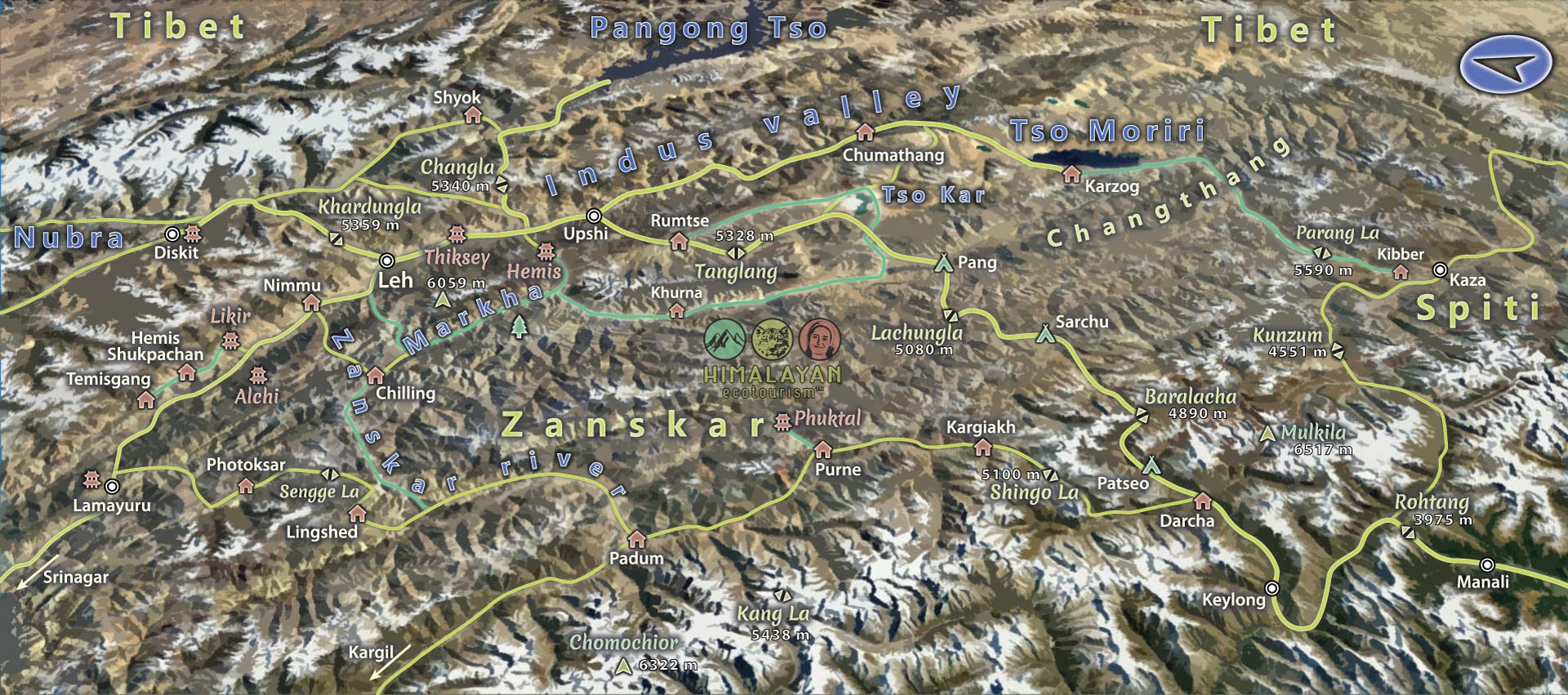Sham valley trek (baby trek)
Hemis Shukpachan is a traditional village on the trek in Sham valley in Ladakh.
Hemis Shukpachan could be a close contender for the mythical Shangri-La.
Hemis Shukpachan is a beautiful traditional village far from the crowds of Ladakh. It has a few home stays where one can stay for a taste of traditional Ladakhi village life. Several treks are possible from and to Hemis Shukpachan to Lamayuru monastery via Ang village, and to Likir Monastery.
The classic off the beaten path trek from Likir Monastery to Temisgam via Yangthang, Hemis Shukpachan and Ang is known as the Sham valley trek and is a gentle, easy and comfortable 3 days trek which takes one through traditional Ladakhi villages.
Hemis Shukpachan is traditional and classic Ladakh at its best. Summers are warm, dry and sunny, the people hospitable, and the crowds non-existent.


Sham valley trek features
Duration of your trek
Day-min : The minimum number of days required for the trek (from Leh to Leh)
Day-max : The maximum number of days you can spend on this trek. Prolonged itinerary can be discussed with our team.
AWTD : Average walking time per day (<3 : easy, 3 to 5 : moderate, >5 : strenuous)
Altitudes of your trek
Min : Minimum altitude of your trek.
Max : Maximum altitude of your trek.
Ascent : The total ascending difference of altitude on the trek.
Descent : The total descending difference of altitude on the trek.
Difficulty of your trek
Stamina : The physical effort involved during your trek. Rated from 0 (easiest) to 100 (most strenuous). If you have an average fitness you can consider all the treks up to 50. See here for more details
Technical : Difficulty of your trek in terms of exposure to danger and required experience.
0 to 20 : No difficulties,
20 to 40 : Walking on good mountain trails,
40 to 60 : Some walking on difficult mountain trails (steep slopes, rocks, etc.),
60 to 80: You are exposed to some dangers (void, snow, falling rocks, etc.),
80 to 100 : Experience required (please inquire).
Overall : Average between Stamina and Technical rating.
Duration
Altitudes
Difficulty


Sham valley trek, best time to go
Best time to trek in Zanskar is from May to September.
You can also consider January and February for the famous Chadar trek on the frozen Zanskar river or for observation of the Snow Leopard.
JAN
Avoid
FEB
Avoid
MAR
Avoid
APR
Avoid
MAY
You may go
JUN
Best time to go
JUL
Best time to go
AUG
Best time to go
SEP
Best time to go
OCT
You may go
NOV
Avoid
DEC
Avoid
From our gallery
Zanskar trek photos
Itinerary
Day One - Likir to Yangthang
| FEATURES | DESCRIPTION |
|---|---|
| 4 hours +430m / -270m Homestay | It take 2 hour drive from Leh to Likir monastery, or you can spend the night before the trek at Likir. That first day will be around 4 hour trek from Likir monastery to Yangthang village. You will go through the pass called Phobe La at 3550 m. You will surely enjoy the hospitality of your hosts at the homestay ! |
Day Two - Yangthang to Hemis Shukpachan
| FEATURES | DESCRIPTION |
|---|---|
| 4 hours +240m / -280m Homestay | Today, your trek is from Yangthang village to Hemis Shukpachan village over the Tsermanchen-La Pass at 3750 m. You will enjoy the beautiful statue of Buddha in the middle of the village. You have a choice of staying either in a homestay or in a guesthouse. In all the case, enjoy the greenery of the villaghe and the traditional Ladakhi food ! |
Day Three - Hemis Shukpachan to Temisgam
| FEATURES | DESCRIPTION |
|---|---|
| 4 hours +310m / -725m Homestay | You leave Hemis Shukpachan after your traditional Ladakhi breakfast. It is a a gentle climb to reach the Mebtak La at around 3750m. Then you descent to Temisgam via the Ang village. You can drive back to Leh, but we advise you to stay in a nice boutique in the village. |
Gallery
Zanskar trek photos
Share your feedback
Thank you for sharing your experience! Your feedback is invaluable and inspires fellow travelers to choose responsible tourism when they journey with us.



















